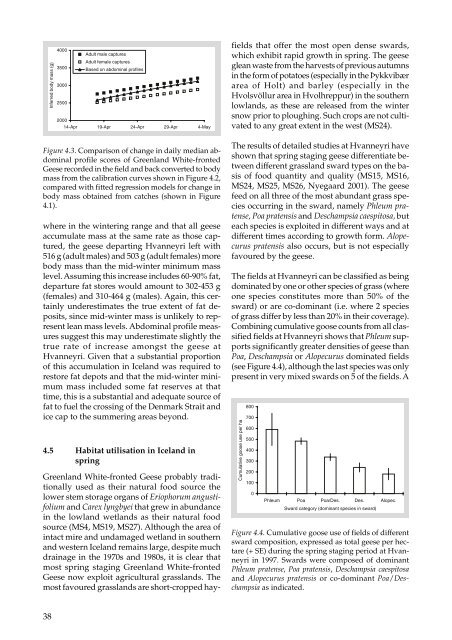The Greenland White-fronted Goose Anser albifrons flavirostris
The Greenland White-fronted Goose Anser albifrons flavirostris
The Greenland White-fronted Goose Anser albifrons flavirostris
You also want an ePaper? Increase the reach of your titles
YUMPU automatically turns print PDFs into web optimized ePapers that Google loves.
Inferred body mass (g)<br />
Figure 4.3. Comparison of change in daily median abdominal<br />
profile scores of <strong>Greenland</strong> <strong>White</strong>-<strong>fronted</strong><br />
Geese recorded in the field and back converted to body<br />
mass from the calibration curves shown in Figure 4.2,<br />
compared with fitted regression models for change in<br />
body mass obtained from catches (shown in Figure<br />
4.1).<br />
where in the wintering range and that all geese<br />
accumulate mass at the same rate as those captured,<br />
the geese departing Hvanneyri left with<br />
516 g (adult males) and 503 g (adult females) more<br />
body mass than the mid-winter minimum mass<br />
level. Assuming this increase includes 60-90% fat,<br />
departure fat stores would amount to 302-453 g<br />
(females) and 310-464 g (males). Again, this certainly<br />
underestimates the true extent of fat deposits,<br />
since mid-winter mass is unlikely to represent<br />
lean mass levels. Abdominal profile measures<br />
suggest this may underestimate slightly the<br />
true rate of increase amongst the geese at<br />
Hvanneyri. Given that a substantial proportion<br />
of this accumulation in Iceland was required to<br />
restore fat depots and that the mid-winter minimum<br />
mass included some fat reserves at that<br />
time, this is a substantial and adequate source of<br />
fat to fuel the crossing of the Denmark Strait and<br />
ice cap to the summering areas beyond.<br />
4.5 Habitat utilisation in Iceland in<br />
spring<br />
<strong>Greenland</strong> <strong>White</strong>-<strong>fronted</strong> Geese probably traditionally<br />
used as their natural food source the<br />
lower stem storage organs of Eriophorum angustifolium<br />
and Carex lyngbyei that grew in abundance<br />
in the lowland wetlands as their natural food<br />
source (MS4, MS19, MS27). Although the area of<br />
intact mire and undamaged wetland in southern<br />
and western Iceland remains large, despite much<br />
drainage in the 1970s and 1980s, it is clear that<br />
most spring staging <strong>Greenland</strong> <strong>White</strong>-<strong>fronted</strong><br />
Geese now exploit agricultural grasslands. <strong>The</strong><br />
most favoured grasslands are short-cropped hay-<br />
38<br />
4000<br />
3500<br />
3000<br />
2500<br />
Adult male captures<br />
Adult female captures<br />
Based on abdominal profiles<br />
2000<br />
14-Apr 19-Apr 24-Apr 29-Apr 4-May<br />
fields that offer the most open dense swards,<br />
which exhibit rapid growth in spring. <strong>The</strong> geese<br />
glean waste from the harvests of previous autumns<br />
in the form of potatoes (especially in the Þykkvibær<br />
area of Holt) and barley (especially in the<br />
Hvolsvöllur area in Hvolhreppur) in the southern<br />
lowlands, as these are released from the winter<br />
snow prior to ploughing. Such crops are not cultivated<br />
to any great extent in the west (MS24).<br />
<strong>The</strong> results of detailed studies at Hvanneyri have<br />
shown that spring staging geese differentiate between<br />
different grassland sward types on the basis<br />
of food quantity and quality (MS15, MS16,<br />
MS24, MS25, MS26, Nyegaard 2001). <strong>The</strong> geese<br />
feed on all three of the most abundant grass species<br />
occurring in the sward, namely Phleum pratense,<br />
Poa pratensis and Deschampsia caespitosa, but<br />
each species is exploited in different ways and at<br />
different times according to growth form. Alopecurus<br />
pratensis also occurs, but is not especially<br />
favoured by the geese.<br />
<strong>The</strong> fields at Hvanneyri can be classified as being<br />
dominated by one or other species of grass (where<br />
one species constitutes more than 50% of the<br />
sward) or are co-dominant (i.e. where 2 species<br />
of grass differ by less than 20% in their coverage).<br />
Combining cumulative goose counts from all classified<br />
fields at Hvanneyri shows that Phleum supports<br />
significantly greater densities of geese than<br />
Poa, Deschampsia or Alopecurus dominated fields<br />
(see Figure 4.4), although the last species was only<br />
present in very mixed swards on 5 of the fields. A<br />
Cumulative goose use per ha<br />
800<br />
700<br />
600<br />
500<br />
400<br />
300<br />
200<br />
100<br />
0<br />
Phleum Poa Poa/Des. Des. Alopec.<br />
Sward category (dominant species in sward)<br />
Figure 4.4. Cumulative goose use of fields of different<br />
sward composition, expressed as total geese per hectare<br />
(+ SE) during the spring staging period at Hvanneyri<br />
in 1997. Swards were composed of dominant<br />
Phleum pratense, Poa pratensis, Deschampsia caespitosa<br />
and Alopecurus pratensis or co-dominant Poa/Deschampsia<br />
as indicated.


